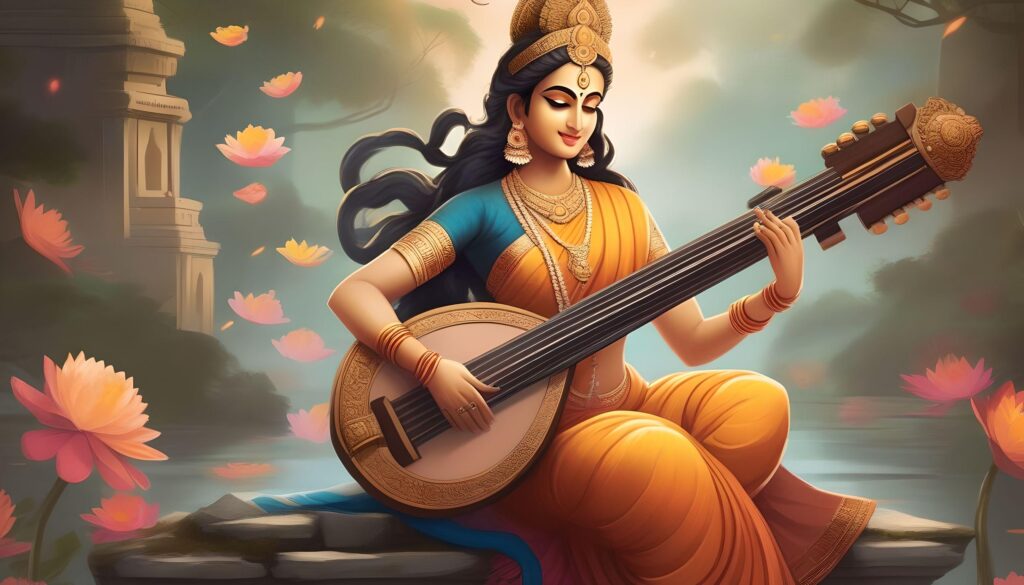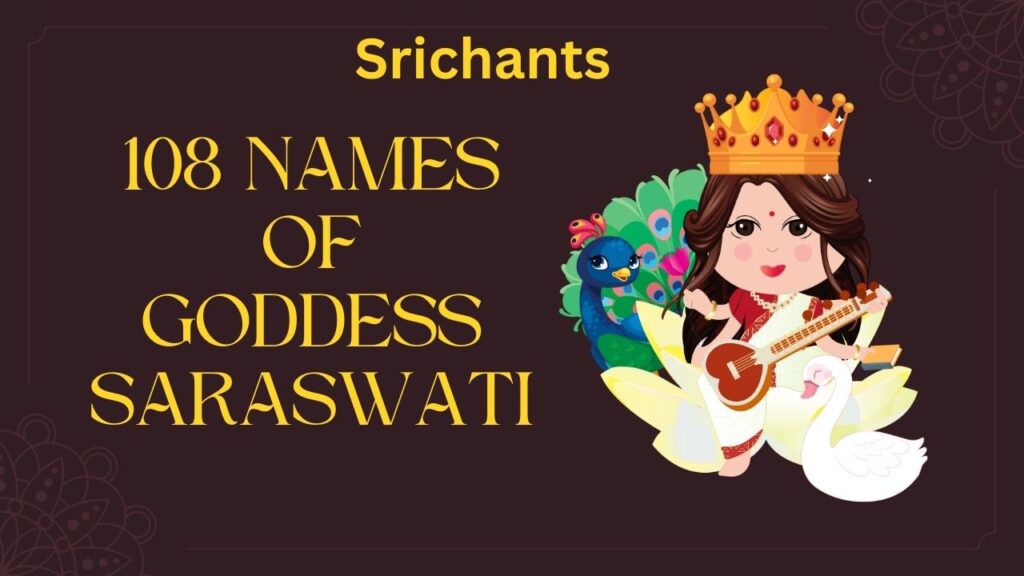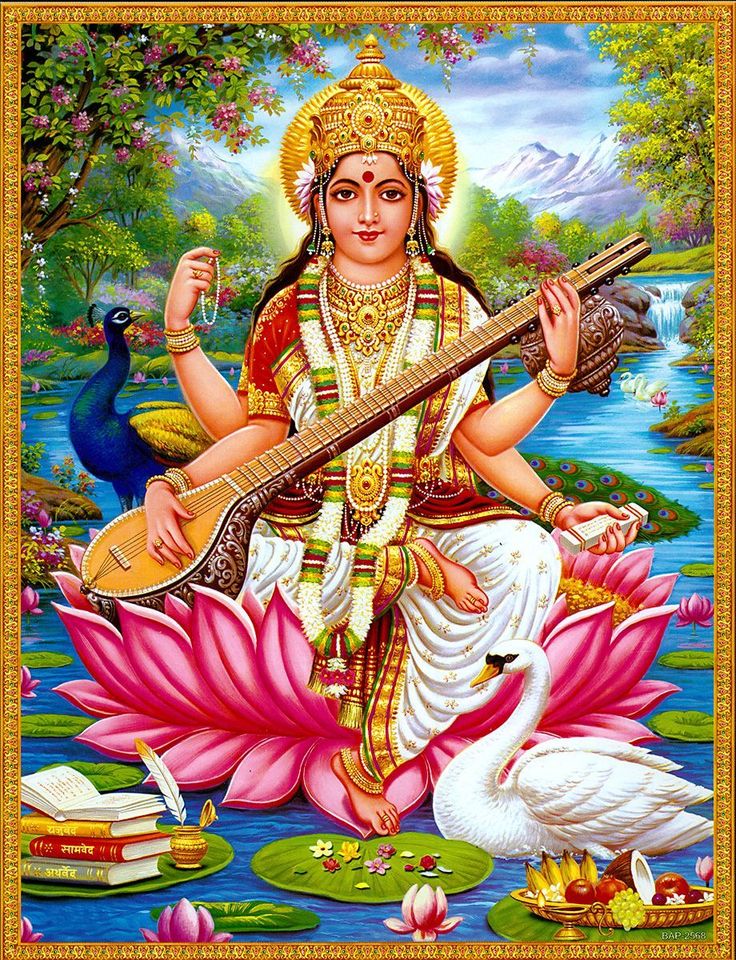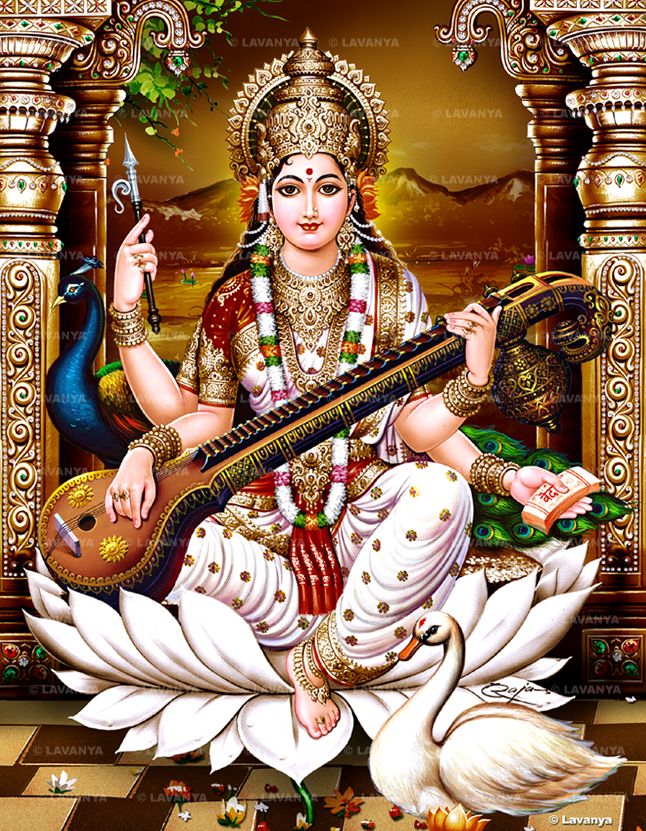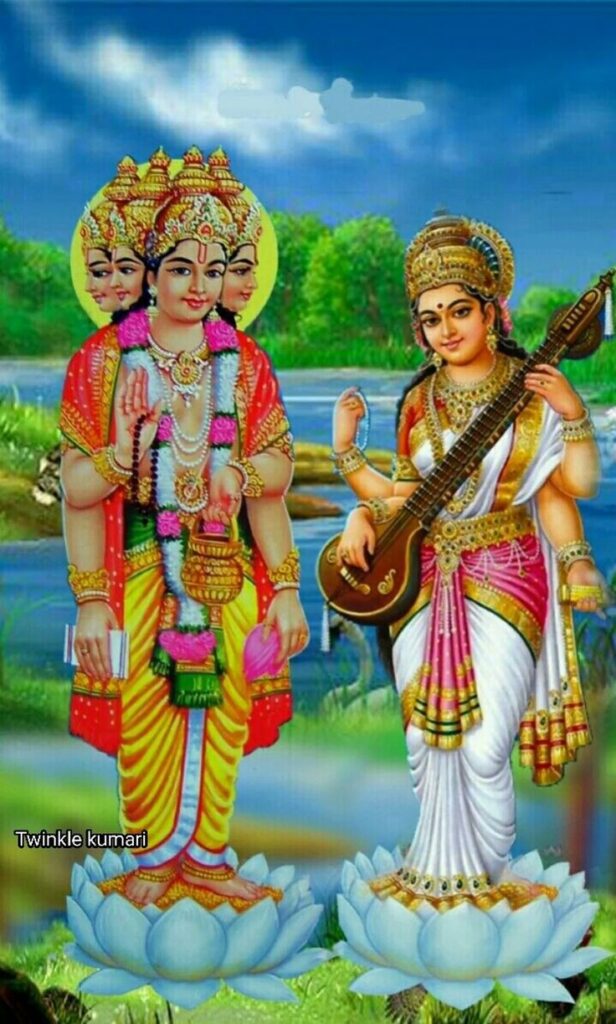Saraswati Iconography: The Symbolism Behind Goddess
Introduction
For millennia devotees of the Hindu faith have been enthralled by Goddess Saraswati, the celestial embodiment of wisdom, knowledge, and the arts. Rich in great symbolism, her iconography provides a window into the several facets of this venerated goddess. Through our thorough investigation, we unearth the great insights hidden inside by exploring the minute features and deep meanings underlying the several ways that Goddess Saraswati is portrayed.
Saraswati’s essence: meaning and significance of Her name
Deep relevance is in the Sanskrit fusion word “Saraswati.” While ‘Sva,’ denotes ‘one’s own,’ or’self,’ the first half, ‘Sara,’ indicates ‘essence,’ or ‘the greatest.'” Saraswati’s name might thus be understood as the ‘essence of wisdom’ or as the ‘essence of one’s own self.'” Moreover, the Sanskrit words “surasa-pai,” which mean “one with plenty of water,” suggest her relationship with the river Saraswati and the ideas of cleanliness and fertility.

Goddess of Arts and Knowledge
Respected as the goddess of knowledge, wisdom, arts, and any kind of creative expression is Saraswati. She is the partner and Shakti of the creator god, Brahma, so embodying the creative force underlying the expression of the universe. Her helps the heavenly knowledge and creative power required for the act of creation to be focused.
Four-Armed Goddess: Significance and Symbolism
Usually showing four arms, each bearing a symbolic object, Goddess Saraswati is These four limbs capture the multifarious character of her heavenly essence:
Veena: Harmony and Creative Expression
Saraswati grips the Veena, a stringed musical instrument, one hand. This reflects her function as supporter of the arts, music, and creative expression. The Veena stands for the harmony and balance one should foster inside themselves and in their contacts with the environment.
The scriptures: the Vedas and embodiment of knowledge
Usually the Vedas, another hand of the goddess carries a book or scriptures, which stand for the embodied knowledge, both holy and secular. This represents Saraswati’s function as the provider and guardian of all wisdom.
Mala: Spiritual Enlightenment and Discipline
Held in one of Saraswati’s hands, the rosary or mala beads reflect the value of meditation, discipline, and concentration in the road of spiritual enlightenment. This reminds us that the development of inner peace and harmony is equally important in true knowledge than only cerebral mastery.
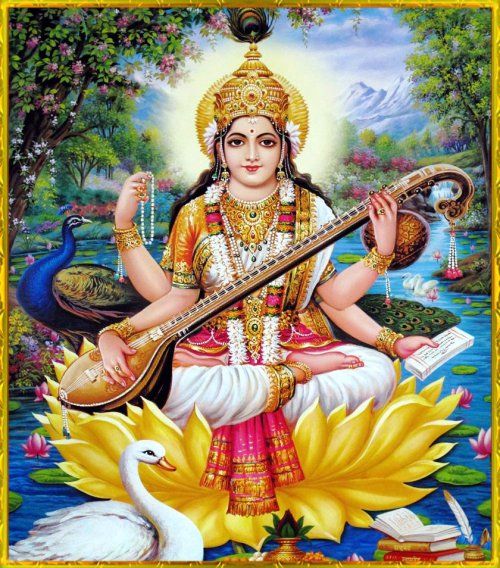
Lotus: Transcendence and Purity
Often holding a lotus flower, which stands for purity, knowledge, and the capacity to transcend the defects of the earthly, the fourth hand represents The lotus, which blossoms in the dirty waters but stays unaltered by them, stands for the goddess’s transcendence and the need of people to keep unaffected by the bad influences that could surround them.
The Goddess’s Attire and Accessories: Symbolic Interpretive Notes
The several components of Saraswati’s clothing and accessories, each of which has great symbolic importance, enhance her iconography even more.
The White Sari: Enlightenment Purity
Usually shown as wearing a perfect white sari, the goddess stands for purity, clarity, and the search of enlightenment. White is the hue of truth and connected with the divine domain, so indicating Saraswati’s transcendence of the earthly reality.
Peacock and Swan: Opposing Characteristics
Often accompanying Saraswati, the peacock represents both beauty and conceit. Its presence reminds us to minimize the bad aspects of indecision and pride. On the other hand, the swan, which is supposed to have the special capacity to separate milk from water, stands for the requirement of judgment and the capacity to tell good from bad.
Variations of Saraswati’s Iconography: Interpretations and Adaptations
Although the most often known is the conventional four-armed portrayal of Goddess Saraswati, her iconography has evolved over time and across many regional and cultural settings in various variants.
The Five-faced Saraswati: Transcendent Embodiment
In some depictions, Saraswati has five faces, each signifying a different facet of her divine character. Considered the embodied transcendent, all-encompassing knowledge and power of the goddess, this form is called Maha Saraswati.
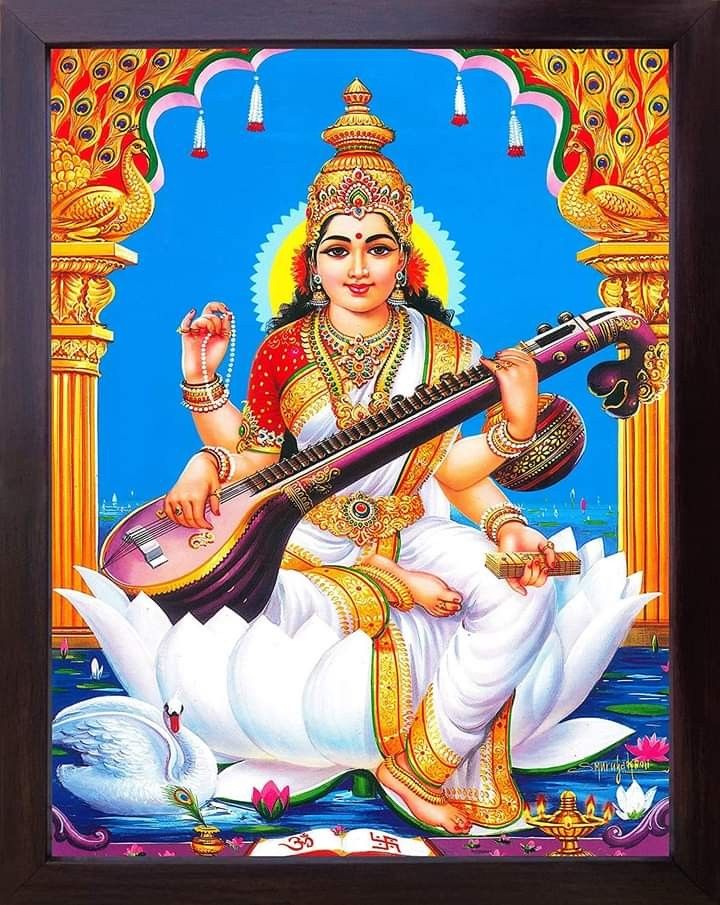
The Eight-Armed Saraswati: Expansion of Divine Attributes
Saraswati is shown in some representations with eight arms, each with a particular symbolic meaning. From the arts and sciences to the spiritual and material spheres, this portrayal stresses the multifarious character of the goddess and her rule over a great range of domains.
Iconography of Saraswati in Hindu Temples and Shrines
Across the Hindu globe, Shrines and temples honouring Goddess Saraswati abound; many of them lie near Shiva or Brahma temples. Each with their own distinct regional and cultural inspirations, these holy sites frequently show the goddess in complex and breathtaking forms.
the Roorkee, India Saraswati Temple
One such example is the Saraswati Temple housed in Uttarakhand, India’s University of Roorkee—now the Indian Institute of Technology Roorkee. Renowned for its superb marble sculpture of the goddess, this temple shows her in her four-armed form surrounded by symbolic objects including the lotus, the Vedas, and the Veena.
Saradamba Temple in Sringeri, Karnataka
Considered among the most prominent hubs of Advaita Vedanta philosophy, the Saradamba Temple in Sringeri, Karnataka, is another notable Saraswati temple. The main shrine of the temple presents a magnificent picture of the goddess, highlighting her heavenly qualities and demanding the respect of both academics and believers.
Saraswati Mantra and Practices: Calling out the Blessings of the Goddess
Reciting holy mantras and carrying out rites to call Goddess Saraswati blessings and seek her divine direction is common activity among her devotees. The most well-known among these is the Saraswati Mantra, which is said to respect the goddess and ask her favor.
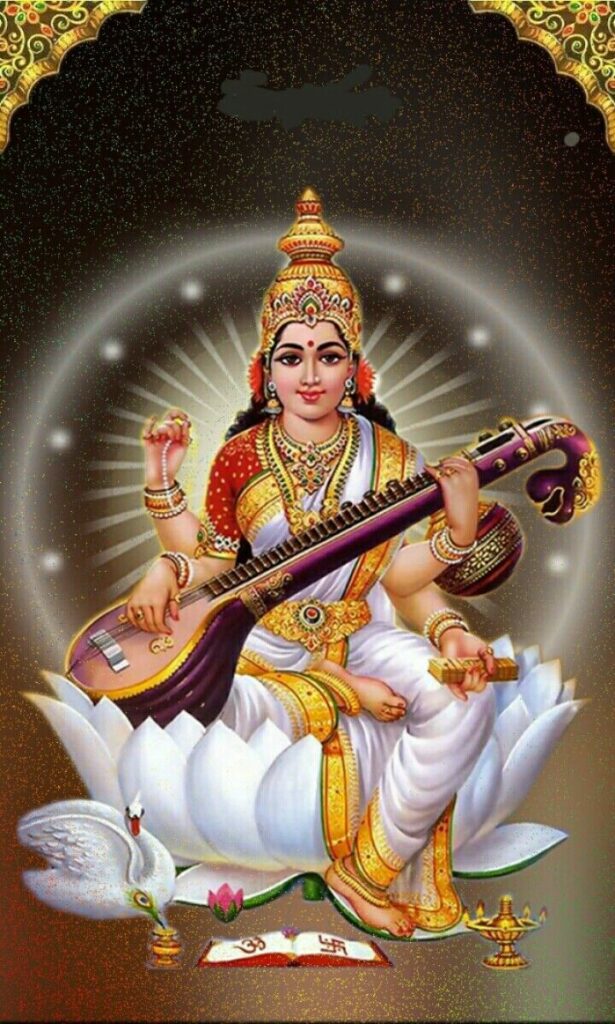
The Saraswati Mantra
Powerful invocation resonating with the core of the goddess, the Saraswati Mantra—also known as the Mula Mantra—resonates with Translating “Om Aim Saraswatyai Namah,” or “Om Sum Saraswathaye Namah,” the mantra becomes “Salutations to the Goddess Saraswati.”
Panchami Celebrations and Saraswati Puja
Apart from the mantras said, Saraswati is also revered through other celebrations and ceremonies; the most important one is Vasant Panchami. Celebrated yearly on the fifth day of the Indian month of Magha (usually in late January or early February), Vasant Panchami honors and respects Goddess Saraswati’s birthday.
Saraswati, Goddess, as the Flowing Waters of Knowledge
Furthermore closely connected to Saraswati’s imagery is the river Saraswati, revered and purifying watercourse in Hindu mythology. Often shown with water or a river in the backdrop, the goddess represents her link to the flowing knowledge and wisdom.
The Saraswati River: An Interpretive Trip Through Mythology and spirituality
Believed to have started in the divine domain, the river Saraswati is connected with the idea of a spiritual pilgrimage or migration from ignorance to knowledge. The river’s image captures this change, whereby the devotee sheds their old self and is reborn, free and illuminated.
The Goddess as the River Embodiment Flowing Through Time
Emphasizing the goddess’s position as the source and sustainer of all knowledge, both holy and secular, the Hindu tradition presents Saraswati as the flowing river. Saraswati is considered as the source of the necessary food for the expansion and flowering of all kinds of learning and creative expression, just as the river nourishes the country and its people.
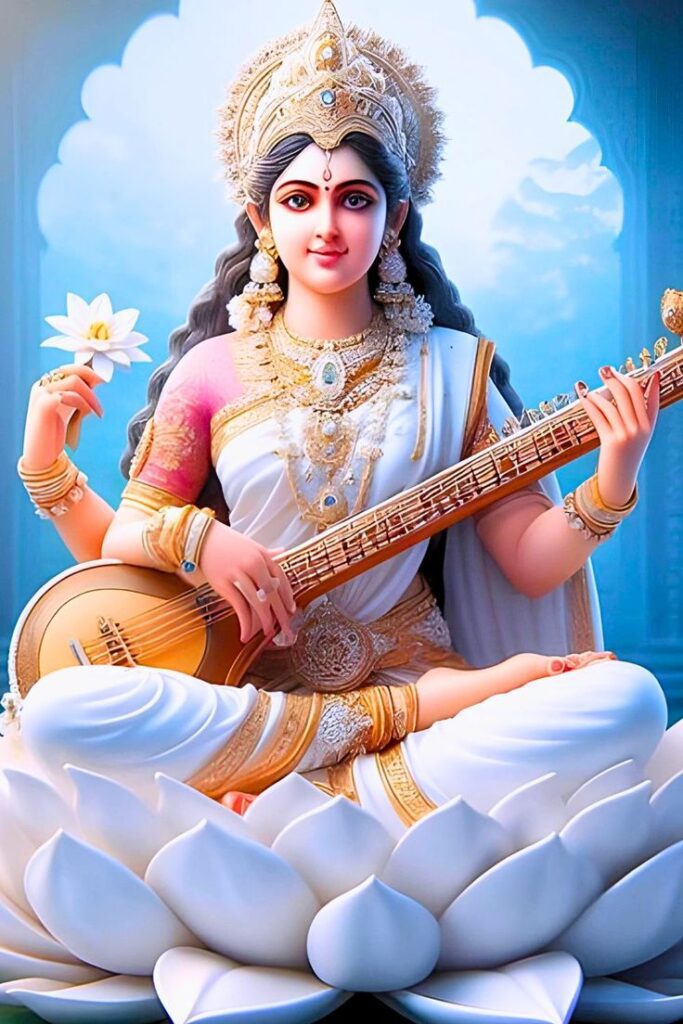
Saraswati within the Wider Hindu Pantheon: Relationships and Synergies
Particularly the trimurti (triangle) of Brahma, Vishnu, and Shiva, Goddess Saraswati’s iconography and importance are profoundly entwined with the larger Hindu pantheon. Her position as Brahma’s consort, the creator, is evidence of the close interaction among knowledge, imagination, and the expression of the world.
Parvati, Lakshmi, and Saraswati: the Triumvirate of Feminine Divine Power
Often teamed with the deities Lakshmi and Parvati, Saraswati forms a trio of feminine heavenly might. Saraswati stands for wisdom and the arts; Lakshmi for money and success; Parvati for the divine mother and the force of spiritual development.
The Feminine Triad in Synnergy with the Trimurti
The harmonic interaction between the feminine triad and the masculine trimurti represents the complimentary character of the divine characteristics of creation, preservation, and transformation. As the companion of Brahma, the creator, Saraswati’s part emphasizes the critical part knowledge and wisdom play in the act of manifestation and the unfolding of the cosmic order.
Conclusion
Offering great insights on the nature of knowledge, creativity, and the search of enlightenment, the rich and multifarious iconography of Goddess Saraswati continues to enthralls both researchers and devotees. Saraswati’s continuing legacy is a timeless inspiration guiding us on the road of intellectual and spiritual development as the embodiment of wisdom, the arts, and the flow of language.
Saraswati’s iconography and lessons are still extremely pertinent in the present period, reminding us of the need of fostering a harmonic balance between the material and the divine, the intellectual and the artistic, the individual and the universal. Understanding and appreciating the great symbolism of Goddess Saraswati can help us to release the transforming power inside us and enable our communities to negotiate the complexity of the modern world with grace, knowledge, and a great respect for the sacred.
#Saraswati #Saraswatis #iconography #Saraswatisymbol #hindu #Goddess
